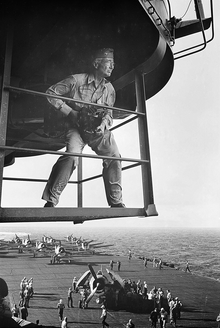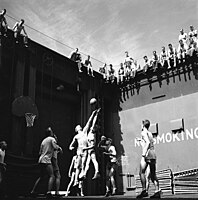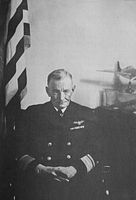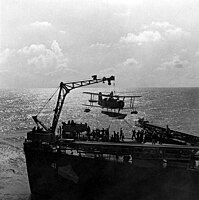Naval Aviation Photographic Unit


Naval Aviation Photographic Unit (česky: Fotografický útvar letectva vojenských námořních sil[zdroj?]) byla skupina válečných fotografů Námořnictva Spojených států amerických během druhé světové války, kterou vedl Edward Steichen.[1]
Historie
Námořnictvo založilo tuto zvláštní skupinu na počátku roku 1942, krátce po vstupu USA do války – tedy krátce poté, co Japonsko zaútočilo na Pearl Harbor -, aby dokumentovalo a propagovalo svou činnost v oblasti letectví a nařídilo Steichenovi najmout ty nejtalentovanější fotografy. Steichen a jeho útvar spadal pod velení kapitána Arthura Radforda a byl součástí námořního oddělení zduchoplavectví.[1]
Hlavním účelem skupiny bylo podporovat nábor pilotů speciálně pro námořnictvo. Radford chtěl nalákat piloty na toto atraktivní povolání zveřejňováním fotografií v tisku, na plakátech, letácích a s pomocí NAVY dosáhnout 30.000 nových pilotů ročně.[2]
Wayne Miller, jeden z fotografů jednotky, vzpomíná na Steichnovy pokyny takto: „Je mi jedno, jak to uděláte, Wayne, ale přineste zpátky něco, co potěší důstojníka, mateřskou letadlovou loď nebo někoho se zlatou lemovkou; zbytek svého času strávíte fotografováním muže.“ Steichenovým prvořadým zájmem nebyly fotografie války, ale fotografie muže, mladého hocha, utrápeného bojovníka a hlavně sny tohoto muže. Fotografie námořníka.[2]
Členové
Skupina fotografů, které Steichen vybral:
- Poručík Wayne Miller[1]
- Poručík Dwight Long[1] (specialista na film, ne fotografii jako takovou)
- Poručík Charles E. Kerlee[1]
- Poručík Charles Fenno Jacobs[1]
- Poručík Horace Bristol[1]
- Victor Jorgensen[1]
- Alfonso ("Fons") Iannelli[1]
Steichen také požádal Ansela Adamse, jestli by nechtěl vést temnou komoru a laboratoř ve Washingtonu, D.C.[3] Přibližně v únoru 1942 se Steichen Adamse zeptal, zda by nechtěl do společnosti vstoupit.[3] Adams souhlasil s dvěma podmínkami: Chtěl získat hodnost důstojníka a pracovat až od 1. července.[3] Steichen však chtěl dát skupinu dohromady co možná nejrychleji, a proto místo Adamse vybral jiné fotografy, kteří byli připraveni nastoupit již od začátku dubna.[3]
Práce
Fotografie pořízené útvarem se staly základem nejméně dvou knih:
- Power In the Pacific — sestavil Steichen a snímky také doprovázely výstavu se stejným názvem v Muzeu moderního umění.[4]
- The Blue Ghost — záznam z pobytu Steichena na palubě lodi USS Lexington (CV-16) z podzimu 1943.[5]
Galerie
- Budoucí prezident Gerald Ford při výskoku nalevo na palubě lodi USS Monterey, foto: Victor Jorgensen, 1944.
- Portrét sira Johna S. McCaina st., foto: Edward Steichen, 1943.
- Letoun se vrací na USS Lexington (CV-16) během Gilbertovy operace, listopad 1943, foto: Edward Steichen.
- Jeřáb nakládá letoun na palubu lodi USS Philadelphia, foto: Horace Bristol.
- Členové posádky USS Saratoga vytahují zraněného pilota ze zadní věže letounu Grumman TBF Avenger, foto: Wayne Miller.
- Letouny Grumman F6F Hellcat na lodi USS Yorktown (CV-10), 1943
Odkazy
Reference
- ↑ a b c d e f g h i Faram, Mark D. (2009), Faces of War: The Untold Story of Edward Steichen's WWII Photographers, Berkeley Caliber, New York, New York, ISBN 978-0-425-22140-2
- ↑ a b Phillips, Christopher (1987), Steichen at War, Portland House, New York, New York, ISBN 0-517-63227-6
- ↑ a b c d Alinderová, Mary Street (1996), Ansel Adams: A Biography, Henry Holt and Co., New York, New York, ISBN 0-8050-4116-8
- ↑ Steichen, Edward (1945) (compiled by), Power In the Pacific, US Camera Publishing Corp, New York, New York
- ↑ Steichen, Edward (1947), The Blue Ghost, Harcourt, Brace, and Co., New York, New York
Externí odkazy
 Obrázky, zvuky či videa k tématu Naval Aviation Photographic Unit na Wikimedia Commons
Obrázky, zvuky či videa k tématu Naval Aviation Photographic Unit na Wikimedia Commons
Média použitá na této stránce
View of the flight deck of the U.S. Navy aircraft carrier USS Lexington (CV-16) with aircraft of Carrier Air Group 16 (CVG-16) landing, in November 1943. Crewmen in the foreground are sitting on the wing of a Douglas SBD-5 Dauntless of Bombing Squadron 16 (VB-16), as a Grumman F6F-3 Hellcat of Fighting Squadron 16 (VF-16) lands and a Grumman TBF-1 Avenger of Torpedo Squadron 16 (VT-16) taxiies to a parking place on the forward flight deck.
Cmdr Edward Steichen photographed above the deck of the aircraft carrier USS Lexington by Lt Victor Jorgensen, November, 1943.
Curtiss SOC "Seagull" scout-observation aircraft is hoisted on board USS Philadelphia (CL-41), during the North African operation, November 1942. Note crewmen holding lines to steady the plane as the aircraft crane swings it inboard.
Two U.S. Navy Curtiss SB2C-3 Helldiver aircraft from Bombing Squadron 11 (VB-11) bank over the aircraft carrier USS Hornet (CV-12) before landing, following strikes on Japanese shipping in the China Sea, circa mid-January 1945.
Crewmen aboard USS Saratoga lift AOM 2nd Class Kenneth Bratton, USNR, out of a TBF Avenger's rear turret after a raid on Rabaul on 5 November 1943. He was wounded by 7.7mm bullets in his left knee and upper thigh. The aircraft and a friendly F6F Hellcat (LTJG Stanley K. Crockett) successfully fought off eight attacking Zeroes, claiming three. Crockett's F6F had 268 bullet holes (54 in the cockpit area), TBF "19" of VT-19 had 109 bullet holes, with hydraulics, elevators and intercom shot up – despite that the pilot Commander Henry Caldwell made an almost perfect one-wheel down arrested landing. Bratton, ACRM (radioman and ventral tunnel gunner) Robert W. Morey (wounded in shoulder, face, and neck) and pilot Caldwell survived. Photographer's Mate Paul Barnett was killed in action – the back of his head torn off by a 7.7mm bullet.
Sign on Tarawa illustrates Marine humor and possible lack of optimism as to duration of war. June 1944.
- NARA FILE #: 080-G-476304 WAR & CONFLICT BOOK #: 1197
"Activities aboard USS Monterey (CVL-26). Navy pilots in the forward elevator well playing basketball., ca. 06/1944"
Jumper of the left is future U.S. President Gerald Ford[1][2]
The U.S. Navy aircraft carrier USS Yorktown (CV-10) during the Marcus Island raid on 31 August 1943: Lt. Comdr. James H. "Jimmy" Flatley,Commander of Air Group 5 (CAG-5), sits in his Grumman F6F-3 Hellcat (code "00"), painted in a tricolor-scheme (certainly an "in the field" application) before takeoff. An Aviation Boatswain Mate stands ready to remove chock from wheels. A non-specular insignia white diagonal stripe on the tail and the green propeller hub signified CAG-5 aboard the Yorktown.
Rear Admiral John S McCain, Sr, photographed by Cmdr Edward Steichen, then of the Naval Aviation Photographic Unit, in 1943. The photo uses the style of Steichen's work for "Vanity Fair" during the 1920s and '30s.















